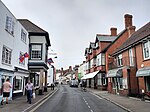RSPB Bowling Green Marsh

Bowling Green Marsh is a nature reserve located on the confluence of the River Exe (at the top end of its estuary) and the River Clyst, near the town of Topsham in Devon. It is managed by the RSPB. Migratory birds including Siberian brent geese, come to the marsh in the winter to feed. It is a major point of interest for birders across South West Britain, with many rare species present at any one time. Other visitors include osprey, wigeon, teal, avocet and black-tailed godwit, and many other waders. Several fish species inhabit the marsh's many pools. Otters have been sighted here, as well. There is a wheelchair-accessible bird hide on the marshes and a viewing platform, reached by steps, with views down the estuary. Occasionally, very rare vagrants, such as Barrow's goldeneye or king eider, stop at the marshes on their migration.
Excerpt from the Wikipedia article RSPB Bowling Green Marsh (License: CC BY-SA 3.0, Authors, Images).RSPB Bowling Green Marsh
Riversmeet, Exeter
Geographical coordinates (GPS) Address Website External links Nearby Places Show on map
Geographical coordinates (GPS)
| Latitude | Longitude |
|---|---|
| N 50.678333333333 ° | E -3.4555555555556 ° |
Address
Bowling Green Marsh
Riversmeet
EX3 0BE Exeter
England, United Kingdom
Open on Google Maps











